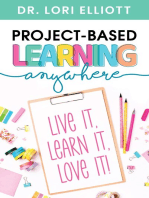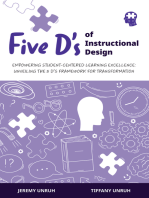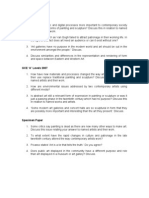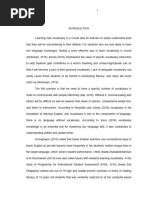Intro To Teaching - Module 3
Uploaded by
api-236265531Intro To Teaching - Module 3
Uploaded by
api-236265531MODULE THREE
Module Three Tonya Williams Texas A&M Commerce
This paper was prepared for Introduction to Teaching ELED 300, taught by Dr. Laura Isbell
MODULE THREE
After reading chapters seven, eight, nine, ten, and eleven in Learning & Teaching Research Based Methods, by Don Kauchak and Paul Eggen and Competencies seven and eight, I found the information to be essential for someone who aspires to become a teacher. I believe the most important topics discussed in the reading materials are cooperative learning, direct teaching, lecture discussions, guided discovery and problem-based learning. These are all essential components to being a successful teacher. Cooperative learning is a fun and interactive way for students to learn. What interests me about cooperative learning is that learning is a social activity. I have always believed that more can be accomplished through a community than just an individual. There are many benefits to cooperative learning; students are motivated, they learn to work with each other, it is fun, and the teacher/student reach their goals. Most importantly the student is held accountable; it is harder to let a peer down than oneself. The bottom line, students learn! The book provided helpful suggestions for some of the downsides that you could encounter using this teaching method such as higher noise levels, failure to get along and ineffective use of time. For noise levels you can remind the students to use their quiet voices. As for not getting along with a peer, I liked the idea of having the students do an activity that helps them recognize what they have and do not have in common. For ineffective use of time, a teacher just moving around the room and listening will help eliminate most of this. However, I find the benefits out weigh the negatives. Outside of cooperative learning, I believe there is a place for direct teaching in the classroom.
MODULE THREE
As with cooperative learning, direct instruction is an effective teaching method as well. I would use this approach when I need to teach certain strategies and concepts. I believe there is a time in the classroom a teacher needs to lecture and then guide the student through the material. To be effective at lecturing, I could use lecture discussions. This will help eliminate the passive role a student plays during a lecture. A lecture discussion is a wonderful alternative to strictly lecturing. It will allow me to engage the student, yet allowing me flexibility. Both guided learning and problem-based learning are instructional strategies that can be useful in the classroom as well. I particularly like the way they both motivate the student by using the students natural curiosity. With guided learning, the student is provided a question related to the real world, which automatically hooks the student. I also believe that students are engaged throughout the lesson because it is something that is real to them. By relating it to the real world they develop a deeper understanding of the material. With problem based learning, the student is presented a real world problem and they are then sent on a mission to solve it. The students stay engaged until they have solved the problem. Both of these strategies enhance critical thinking skills and problem solving. Cooperative learning, direct teaching, lecture discussions, guided discovery, and problem-based learning will make the learning experience beneficial for all those involved. Knowing these different teaching strategies and when to use them will give me more to work with when trying to teach my students different concepts and materials. This can only contribute to accomplishing an affective learning experience.
MODULE THREE References
Kauchak, D., & Eggeb, P. (2012). Learning & Teaching Research-Based Methods (sixth ed., pp. 1-104). Boston, MA: Allyn & Bacon.
You might also like
- Tools for Teaching Social Studies: A How-to Handbook of Useful Ideas and Practical SolutionsFrom EverandTools for Teaching Social Studies: A How-to Handbook of Useful Ideas and Practical Solutions5/5 (1)
- Hacking Learning Centers in Grades 6-12: How to Design Small-Group Instruction to Foster Active Learning, Shared Leadership, and Student AccountabilityFrom EverandHacking Learning Centers in Grades 6-12: How to Design Small-Group Instruction to Foster Active Learning, Shared Leadership, and Student Accountability5/5 (4)
- Hacking Questions: 11 Answers That Create a Culture of Inquiry in Your ClassroomFrom EverandHacking Questions: 11 Answers That Create a Culture of Inquiry in Your Classroom5/5 (4)
- How to Teach Anything: Break Down Complex Topics and Explain with Clarity, While Keeping Engagement and MotivationFrom EverandHow to Teach Anything: Break Down Complex Topics and Explain with Clarity, While Keeping Engagement and Motivation4.5/5 (4)
- How to Teach Kids Anything: Create Hungry Learners Who Can Remember, Synthesize, and Apply KnowledgeFrom EverandHow to Teach Kids Anything: Create Hungry Learners Who Can Remember, Synthesize, and Apply KnowledgeNo ratings yet
- Top Ten Strategies for Student Engagement: How to Make the Most of Your Time with Your StudentsFrom EverandTop Ten Strategies for Student Engagement: How to Make the Most of Your Time with Your StudentsNo ratings yet
- Teach Like Nobody's Watching: The essential guide to effective and efficient teachingFrom EverandTeach Like Nobody's Watching: The essential guide to effective and efficient teachingNo ratings yet
- Humanizing Classroom Management: Restorative Practices and Universal Design for LearningFrom EverandHumanizing Classroom Management: Restorative Practices and Universal Design for LearningNo ratings yet
- Classroom Vibe: Practical Strategies for a Better Classroom CultureFrom EverandClassroom Vibe: Practical Strategies for a Better Classroom Culture5/5 (1)
- Classroom-Ready Resources for Student-Centered Learning: Basic Teaching Strategies for Fostering Student Ownership, Agency, and Engagement in K–6 ClassroomsFrom EverandClassroom-Ready Resources for Student-Centered Learning: Basic Teaching Strategies for Fostering Student Ownership, Agency, and Engagement in K–6 ClassroomsNo ratings yet
- The Sustainable Teacher: Practical ways to a better balanceFrom EverandThe Sustainable Teacher: Practical ways to a better balanceNo ratings yet
- Exam Literacy: A guide to doing what works (and not what doesn't) to better prepare students for examsFrom EverandExam Literacy: A guide to doing what works (and not what doesn't) to better prepare students for examsNo ratings yet
- Making Music Cooperatively: Using Cooperative Learning in Your Active Music-Making ClassroomFrom EverandMaking Music Cooperatively: Using Cooperative Learning in Your Active Music-Making Classroom5/5 (1)
- Lectures and Play: A Practical and Fun Guide to Create Extraordinary Higher Education Classroom ExperiencesFrom EverandLectures and Play: A Practical and Fun Guide to Create Extraordinary Higher Education Classroom Experiences5/5 (1)
- English for Students of Educational Sciences: Educational SciencesFrom EverandEnglish for Students of Educational Sciences: Educational SciencesNo ratings yet
- Rebel Educator: Create Classrooms Where Impact and Imagination MeetFrom EverandRebel Educator: Create Classrooms Where Impact and Imagination MeetNo ratings yet
- Morning Meetings for Special Education Classrooms: 101 Fun Ideas, Creative Activities and Adaptable TechniquesFrom EverandMorning Meetings for Special Education Classrooms: 101 Fun Ideas, Creative Activities and Adaptable TechniquesNo ratings yet
- Into the Classroom: A Practical Guide for Starting Student TeachingFrom EverandInto the Classroom: A Practical Guide for Starting Student TeachingNo ratings yet
- People Interacting: 150 Activities to Promote Self Awareness, Communication, Social and Problem-Solving SkillsFrom EverandPeople Interacting: 150 Activities to Promote Self Awareness, Communication, Social and Problem-Solving SkillsNo ratings yet
- Powerful Questioning: Strategies for improving learning and retention in the classroomFrom EverandPowerful Questioning: Strategies for improving learning and retention in the classroomNo ratings yet
- I Is for Inquiry: An Illustrated ABC of Inquiry-Based Instruction for Elementary Teachers and SchoolsFrom EverandI Is for Inquiry: An Illustrated ABC of Inquiry-Based Instruction for Elementary Teachers and SchoolsNo ratings yet
- From Crisis To Tranquility: A Guide to Classroom: Management Organization and DisciplineFrom EverandFrom Crisis To Tranquility: A Guide to Classroom: Management Organization and DisciplineNo ratings yet
- The Beginner's Guide to Cooperative Learning: Make your learners your main teaching resourceFrom EverandThe Beginner's Guide to Cooperative Learning: Make your learners your main teaching resourceNo ratings yet
- Designed to Decrease Aggressive Behavior on the Part of Students in the Classroom: Classroom Behavior ManagementFrom EverandDesigned to Decrease Aggressive Behavior on the Part of Students in the Classroom: Classroom Behavior ManagementNo ratings yet
- Together We Teach - Transforming Education Through Co-Teaching: Quick Reads for Busy EducatorsFrom EverandTogether We Teach - Transforming Education Through Co-Teaching: Quick Reads for Busy EducatorsNo ratings yet
- Project-Based Learning Anywhere: Live It, Learn It, Love It!From EverandProject-Based Learning Anywhere: Live It, Learn It, Love It!No ratings yet
- Powering Up Students: The Learning Power Approach to high school teaching (The Learning Power series)From EverandPowering Up Students: The Learning Power Approach to high school teaching (The Learning Power series)No ratings yet
- Biology Made Real: Ways of Teaching That Inspire Meaning-MakingFrom EverandBiology Made Real: Ways of Teaching That Inspire Meaning-MakingNo ratings yet
- Independent Thinking on Teaching and Learning: Developing independence and resilience in all teachers and learners (Independent Thinking On... series)From EverandIndependent Thinking on Teaching and Learning: Developing independence and resilience in all teachers and learners (Independent Thinking On... series)No ratings yet
- The Teaching Game: A Handbook for Surviving and Thriving in the ClassroomFrom EverandThe Teaching Game: A Handbook for Surviving and Thriving in the ClassroomNo ratings yet
- Teaching Health Professionals Online: Frameworks and StrategiesFrom EverandTeaching Health Professionals Online: Frameworks and StrategiesNo ratings yet
- Being a 21st Century Educator: Five Trends You Really Want to KnowFrom EverandBeing a 21st Century Educator: Five Trends You Really Want to Know3.5/5 (2)
- Five D’s of Instructional Design: Empowering Student-Centered Learning Excellence: Unveiling the 5 D's Framework for TransformationFrom EverandFive D’s of Instructional Design: Empowering Student-Centered Learning Excellence: Unveiling the 5 D's Framework for TransformationNo ratings yet
- Dissertation Sur Le Plan Marshall Et La Bipolarisation Du Monde100% (2)Dissertation Sur Le Plan Marshall Et La Bipolarisation Du Monde6 pages
- Syllabus: Agusan Del Sur State College of Agriculture and TechnologyNo ratings yetSyllabus: Agusan Del Sur State College of Agriculture and Technology11 pages
- Brochure of Utrecht - Nederlands, Studies.No ratings yetBrochure of Utrecht - Nederlands, Studies.9 pages
- Poole-A Companion To Latin American Anthropology100% (1)Poole-A Companion To Latin American Anthropology554 pages
- Behavioral Event Interview: A. Teaching AbilityNo ratings yetBehavioral Event Interview: A. Teaching Ability16 pages
- Susie Tharu On The End of Postcolonial TheoryNo ratings yetSusie Tharu On The End of Postcolonial Theory12 pages
- Teaching Technical English To Hydraulics StudentNo ratings yetTeaching Technical English To Hydraulics Student94 pages
- To Infinity and Beyond A Critique of The Aesthetic White CubeNo ratings yetTo Infinity and Beyond A Critique of The Aesthetic White Cube87 pages
- Bursary Application For Study at Post School Education and Training InstitutionNo ratings yetBursary Application For Study at Post School Education and Training Institution3 pages
- Tools for Teaching Social Studies: A How-to Handbook of Useful Ideas and Practical SolutionsFrom EverandTools for Teaching Social Studies: A How-to Handbook of Useful Ideas and Practical Solutions
- Hacking Learning Centers in Grades 6-12: How to Design Small-Group Instruction to Foster Active Learning, Shared Leadership, and Student AccountabilityFrom EverandHacking Learning Centers in Grades 6-12: How to Design Small-Group Instruction to Foster Active Learning, Shared Leadership, and Student Accountability
- Hacking Questions: 11 Answers That Create a Culture of Inquiry in Your ClassroomFrom EverandHacking Questions: 11 Answers That Create a Culture of Inquiry in Your Classroom
- The Unscripted Classroom: Emergent Curriculum in ActionFrom EverandThe Unscripted Classroom: Emergent Curriculum in Action
- How to Teach Anything: Break Down Complex Topics and Explain with Clarity, While Keeping Engagement and MotivationFrom EverandHow to Teach Anything: Break Down Complex Topics and Explain with Clarity, While Keeping Engagement and Motivation
- How to Teach Kids Anything: Create Hungry Learners Who Can Remember, Synthesize, and Apply KnowledgeFrom EverandHow to Teach Kids Anything: Create Hungry Learners Who Can Remember, Synthesize, and Apply Knowledge
- Top Ten Strategies for Student Engagement: How to Make the Most of Your Time with Your StudentsFrom EverandTop Ten Strategies for Student Engagement: How to Make the Most of Your Time with Your Students
- Teach Like Nobody's Watching: The essential guide to effective and efficient teachingFrom EverandTeach Like Nobody's Watching: The essential guide to effective and efficient teaching
- Humanizing Classroom Management: Restorative Practices and Universal Design for LearningFrom EverandHumanizing Classroom Management: Restorative Practices and Universal Design for Learning
- Classroom Vibe: Practical Strategies for a Better Classroom CultureFrom EverandClassroom Vibe: Practical Strategies for a Better Classroom Culture
- Classroom-Ready Resources for Student-Centered Learning: Basic Teaching Strategies for Fostering Student Ownership, Agency, and Engagement in K–6 ClassroomsFrom EverandClassroom-Ready Resources for Student-Centered Learning: Basic Teaching Strategies for Fostering Student Ownership, Agency, and Engagement in K–6 Classrooms
- The Sustainable Teacher: Practical ways to a better balanceFrom EverandThe Sustainable Teacher: Practical ways to a better balance
- Exam Literacy: A guide to doing what works (and not what doesn't) to better prepare students for examsFrom EverandExam Literacy: A guide to doing what works (and not what doesn't) to better prepare students for exams
- 50 Ways to Be a Better Teacher: Professional Development TechniquesFrom Everand50 Ways to Be a Better Teacher: Professional Development Techniques
- Making Music Cooperatively: Using Cooperative Learning in Your Active Music-Making ClassroomFrom EverandMaking Music Cooperatively: Using Cooperative Learning in Your Active Music-Making Classroom
- Lectures and Play: A Practical and Fun Guide to Create Extraordinary Higher Education Classroom ExperiencesFrom EverandLectures and Play: A Practical and Fun Guide to Create Extraordinary Higher Education Classroom Experiences
- English for Students of Educational Sciences: Educational SciencesFrom EverandEnglish for Students of Educational Sciences: Educational Sciences
- Rebel Educator: Create Classrooms Where Impact and Imagination MeetFrom EverandRebel Educator: Create Classrooms Where Impact and Imagination Meet
- The Art of Teaching with Integrity: Giving Children a VoiceFrom EverandThe Art of Teaching with Integrity: Giving Children a Voice
- Morning Meetings for Special Education Classrooms: 101 Fun Ideas, Creative Activities and Adaptable TechniquesFrom EverandMorning Meetings for Special Education Classrooms: 101 Fun Ideas, Creative Activities and Adaptable Techniques
- Into the Classroom: A Practical Guide for Starting Student TeachingFrom EverandInto the Classroom: A Practical Guide for Starting Student Teaching
- Pedagogies for Student-Centered Learning: Online and On-GoundFrom EverandPedagogies for Student-Centered Learning: Online and On-Gound
- People Interacting: 150 Activities to Promote Self Awareness, Communication, Social and Problem-Solving SkillsFrom EverandPeople Interacting: 150 Activities to Promote Self Awareness, Communication, Social and Problem-Solving Skills
- The Seven R's of Great Group Work: Alphabet Sevens, #3From EverandThe Seven R's of Great Group Work: Alphabet Sevens, #3
- Powerful Questioning: Strategies for improving learning and retention in the classroomFrom EverandPowerful Questioning: Strategies for improving learning and retention in the classroom
- Engaging Practices: How to Activate Student LearningFrom EverandEngaging Practices: How to Activate Student Learning
- Motivating People to Learn: ...And Teachers to TeachFrom EverandMotivating People to Learn: ...And Teachers to Teach
- Elevating Co-teaching with Universal Design for LearningFrom EverandElevating Co-teaching with Universal Design for Learning
- I Is for Inquiry: An Illustrated ABC of Inquiry-Based Instruction for Elementary Teachers and SchoolsFrom EverandI Is for Inquiry: An Illustrated ABC of Inquiry-Based Instruction for Elementary Teachers and Schools
- Active Learning in the Middle Grades ClassroomFrom EverandActive Learning in the Middle Grades Classroom
- From Crisis To Tranquility: A Guide to Classroom: Management Organization and DisciplineFrom EverandFrom Crisis To Tranquility: A Guide to Classroom: Management Organization and Discipline
- The Beginner's Guide to Cooperative Learning: Make your learners your main teaching resourceFrom EverandThe Beginner's Guide to Cooperative Learning: Make your learners your main teaching resource
- Cognitive Load Theory: A handbook for teachersFrom EverandCognitive Load Theory: A handbook for teachers
- Designed to Decrease Aggressive Behavior on the Part of Students in the Classroom: Classroom Behavior ManagementFrom EverandDesigned to Decrease Aggressive Behavior on the Part of Students in the Classroom: Classroom Behavior Management
- Together We Teach - Transforming Education Through Co-Teaching: Quick Reads for Busy EducatorsFrom EverandTogether We Teach - Transforming Education Through Co-Teaching: Quick Reads for Busy Educators
- Project-Based Learning Anywhere: Live It, Learn It, Love It!From EverandProject-Based Learning Anywhere: Live It, Learn It, Love It!
- Powering Up Students: The Learning Power Approach to high school teaching (The Learning Power series)From EverandPowering Up Students: The Learning Power Approach to high school teaching (The Learning Power series)
- Cooperative Learning and Teaching, Second EditionFrom EverandCooperative Learning and Teaching, Second Edition
- Biology Made Real: Ways of Teaching That Inspire Meaning-MakingFrom EverandBiology Made Real: Ways of Teaching That Inspire Meaning-Making
- Independent Thinking on Teaching and Learning: Developing independence and resilience in all teachers and learners (Independent Thinking On... series)From EverandIndependent Thinking on Teaching and Learning: Developing independence and resilience in all teachers and learners (Independent Thinking On... series)
- The Teaching Game: A Handbook for Surviving and Thriving in the ClassroomFrom EverandThe Teaching Game: A Handbook for Surviving and Thriving in the Classroom
- Teaching Health Professionals Online: Frameworks and StrategiesFrom EverandTeaching Health Professionals Online: Frameworks and Strategies
- Being a 21st Century Educator: Five Trends You Really Want to KnowFrom EverandBeing a 21st Century Educator: Five Trends You Really Want to Know
- Five D’s of Instructional Design: Empowering Student-Centered Learning Excellence: Unveiling the 5 D's Framework for TransformationFrom EverandFive D’s of Instructional Design: Empowering Student-Centered Learning Excellence: Unveiling the 5 D's Framework for Transformation
- Dissertation Sur Le Plan Marshall Et La Bipolarisation Du MondeDissertation Sur Le Plan Marshall Et La Bipolarisation Du Monde
- Syllabus: Agusan Del Sur State College of Agriculture and TechnologySyllabus: Agusan Del Sur State College of Agriculture and Technology
- To Infinity and Beyond A Critique of The Aesthetic White CubeTo Infinity and Beyond A Critique of The Aesthetic White Cube
- Bursary Application For Study at Post School Education and Training InstitutionBursary Application For Study at Post School Education and Training Institution






























































































